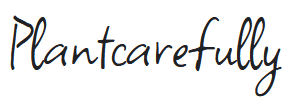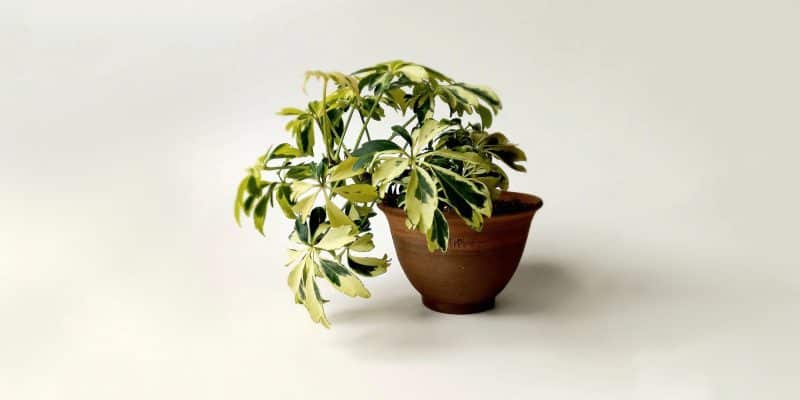Welcome to the world of the Dwarf Umbrella Tree (Schefflera arboricola), a tropical plant that’ll charm its way into your home and heart with its delightful umbrella-like leaves and easygoing nature.
In our Dwarf Umbrella Tree care (or, as it used to be known, Schefflera arboricola care) guide, we’ll fill you in the eye-catching ‘Gold Capella’ variant with its golden-green leaves. We’re also serving up all you’ll need to know to keep this popular houseplant thriving in your indoor garden.
Table of Contents
Dwarf Umbrella Tree Care Guide
History, Habitat, and Characteristics
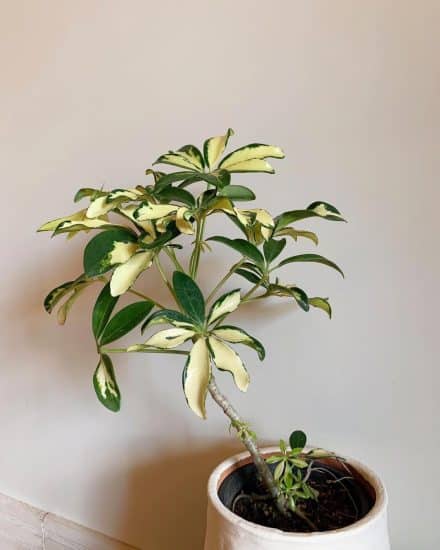
The Dwarf Umbrella Tree has its roots in Taiwan and Hainan, China, where it naturally grows in wet, tropical habitats. You’ll often find this broad leaved evergreen shrub called by its botanical name, Schefflera arboricola, but it has recently been reclassified by scientists and now goes by Heptapleurum arboricola.
No matter what you call it, this evergreen superstar is easy to care for and will add a lasting pop of green to any indoor space.
Besides the typical Dwarf Umbrella Tree, which has glossy, dark green leaves, there are a few variegated cultivars of this plant on the market, such as the ‘Gold Capella,’ which boasts flashy yellow and green leaves.
In contrast to the more commonly grown umbrella plant (Schefflera actinophylla or Heptapleurum actinophyllum), which is a larger species that can reach up to 10 feet tall, the “dwarf” umbrella plant can be grown as a petite container plant (yay for indoor plants!) that will fit nicely in a small space without cramping your style.
Light
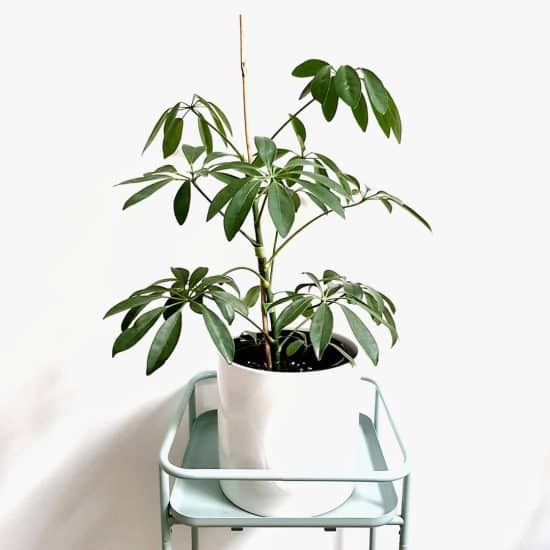
The Dwarf Umbrella Tree is a versatile, easygoing indoor houseplant that loves bright indirect light and even tolerates direct sunlight in the morning and late afternoon. (Note that the beautifully patterned leaves of the ‘Gold Capella’ will burn more easily, so avoid direct sun for this cultivar at any time of day.)
If your plant is basking in too much sunlight, you might notice scorched leaves, fading colors, or curling, brittle or browning leaf edges. In this case, try moving your plant to a spot with less intense light, or add a sheer curtain to the window to tone down the sun’s rays.
If your Schefflera plant is not receiving enough light, its leaves might start dropping or turning yellow. Either move it to a brighter area or give it a boost with an energy-efficient LED grow light.
Lighting tips:
- Give your umbrella plant bright indirect light throughout the day. If it’s getting too much light, use a sheer curtain to filter out the harshest rays of the sun.
- If you’re struggling with finding a bright enough spot for your plant, try adding an LED grow light.
- Rotate your Schefflera plant every few weeks to make sure all of its lovely leaves get their fair share of sunlight. This will help your plant to grow evenly and stay looking its best.
Water
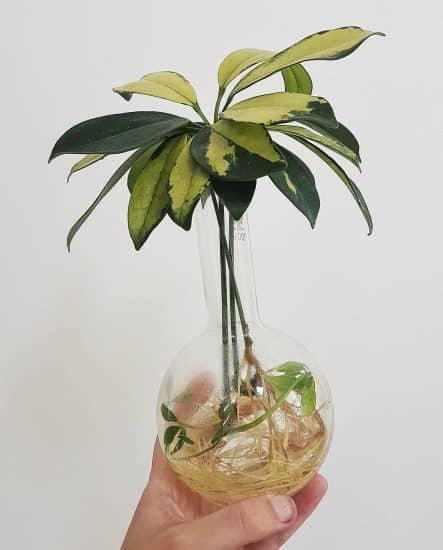
The Dwarf Umbrella Tree is a tropical plant that loves a good drink, but it’s no fan of soaking in water. Give it enough water each time to drain all the way through the pot, but let the soil dry out a bit between waterings. Ensure that the container has drainage holes, and if you’re using a saucer underneath the plant, be sure to dump the excess water out each time you water.
You can encourage faster growth by giving your plant lots of light and adjusting your watering frequency based on how quickly the soil dries out. The amount of water it’ll crave depends on the light it gets — more bright light means more water, while less light means the opposite.
Not enough water can cause the leaves to droop and turn brown and crispy. If you see this happening to your plant, it’s time to up your watering game. A quick tip: poke your finger into the soil a few inches down. If it feels a too dry, that’s your cue to quench your Schefflera plant’s thirst.
On the other hand, too much water can cause yellowing leaves and wilting stems. Even worse, overly wet soil promotes disease that will eventually kill your plant, so reduce your watering frequency and let the soil dry out a bit more before you water each time.
Temperature and Humidity
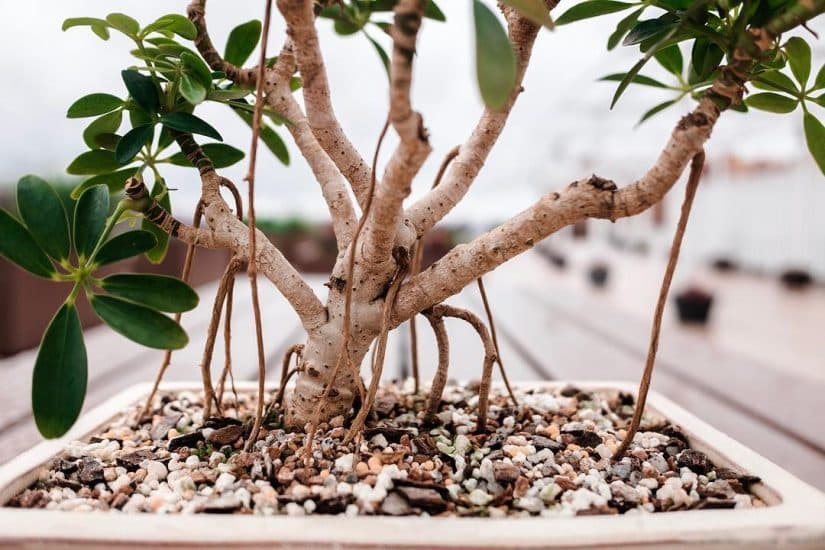
Your Dwarf Umbrella Tree is a tropical species that will thrive in temperatures of 60-75°F. Although it can tolerate temperatures outside of this range, its best to avoid extremes and especially drastic temperature fluctuations. Generally, aim to keep the temperature consistent, within a comfortable range for humans.
Schefflera likes high humidity levels above 60%, but will usually do fine in lower levels found in typical indoor environments. If you notice wilting or browning of the leaf tips or edges, it could mean that the air is too dry for your plant.
If you need to increase humidity, try using a pebble tray under your plant or a room humidifier. You can also regularly mist the leaves of your Schefflera plants — although this will only have a minimal impact on the humidity level, it will help to remove dust and contribute to a healthier appearance.
Humidity tips:
- Use a pebble tray under your umbrella plant to increase the humidity.
- Place a humidifier near your plant.
- Group your Schefflera plant with other tropical plants to create a moist microclimate that they will all benefit from.
Soil and Planting
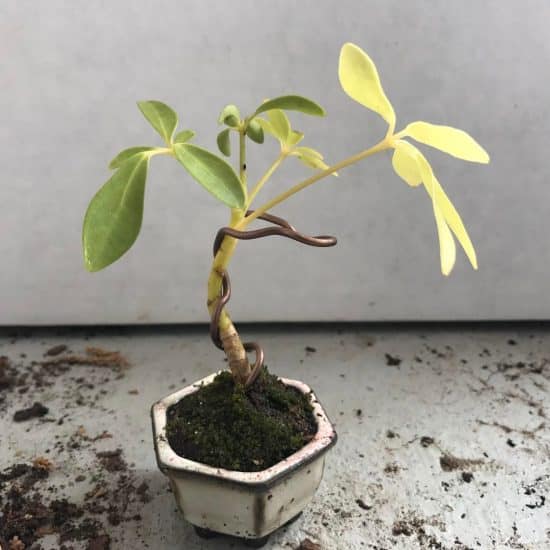
The Dwarf Umbrella Tree thrives in a potting mix that allows for proper water retention as well as good drainage.
An ideal mix for Schefflera plants is a general potting soil used as a base, with added perlite, LECA, or pumice to improve drainage.
Signs of poor soil include yellowing leaves, wilting, and stunted growth. If you notice any of these symptoms on your plant, consider changing the soil to a more suitable mix.
Keep your plant in the same pot for 4 to 6 months before repotting the first time. After this initial period, plan to repot at least once a year during the growing season to encourage growth.
Both terracotta and plastic pots are suitable choices for your plant, as long as they offer adequate drainage.
Fertilizer
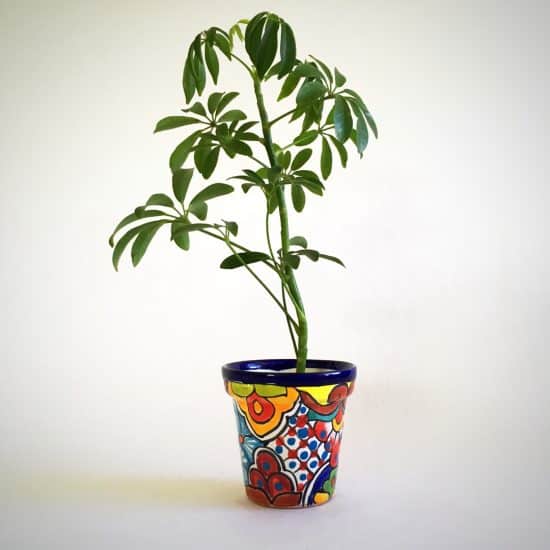
The Dwarf Umbrella Tree appreciates regular fertilization during the growing season (usually March to October). Fertilize your Schefflera houseplants lightly but frequently, using a complete fertilizer. Follow the instructions on the label for best results.
Be mindful of over-fertilizing your Schefflera arboricola, as this can cause more harm than good. Signs of too much fertilizer include leaf burn, browning leaf tips, and leaf drop.
If you suspect over-fertilization, leach excess nutrients out of the soil by watering thoroughly. After that, stop feeding your Schefflera plant for a few weeks until it shows signs of recovery. Resume feeding using a reduced amount of fertilizer.
Propagation
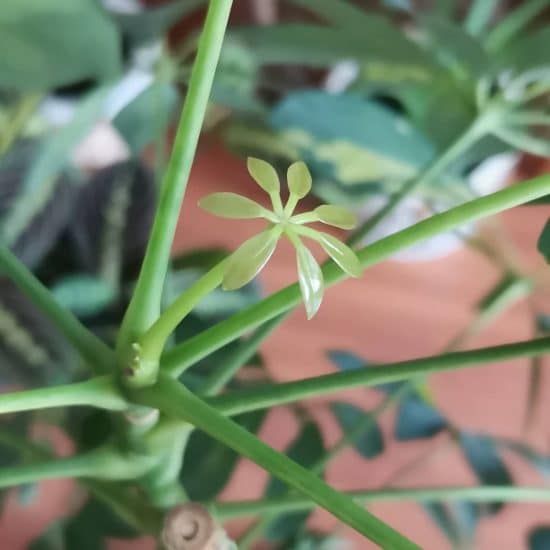
Propagating your Dwarf Umbrella Tree with stem cuttings in soil is our recommended method. It’s fast, fun, and easy, so let’s get started.
Propagate Dwarf Umbrella Tree via stem cuttings:
- Pick a stem: Find a strong and healthy section that includes part of the main stem and at least 3-4 leaves. Using sterilized scissors or pruning shears, make a clean cut just below a leaf node.
- Give your cutting a trim: Remove a few leaves from the bottom part of the stem, leaving 2-3 leaves at the top so that it has energy for root production. Want a bonus tip? Dip the cut end in rooting hormone to speed up root formation, especially if you’re dealing with a woodier stem.
- Plant your cutting: Fill a small pot with well-draining soil mix. Pop the umbrella plant cutting into the mix, ensuring that some of the nodes are placed underground. Firm the soil gently around the stem to secure it in place.
- Place it in a cozy spot: Find a spot with bright indirect light for your plant baby and increase humidity around it until it starts to grow by placing a clear plastic bag over the pot and cutting.
- Keep an eye on the prize: In about a month, you should start seeing signs of new growth on your plant. Give the cutting a gentle tug — if there’s resistance, you’ve got roots brewing!
- Repot when it’s time: Once your newbie’s growth has taken off, repot it into a larger container.
Common Issues
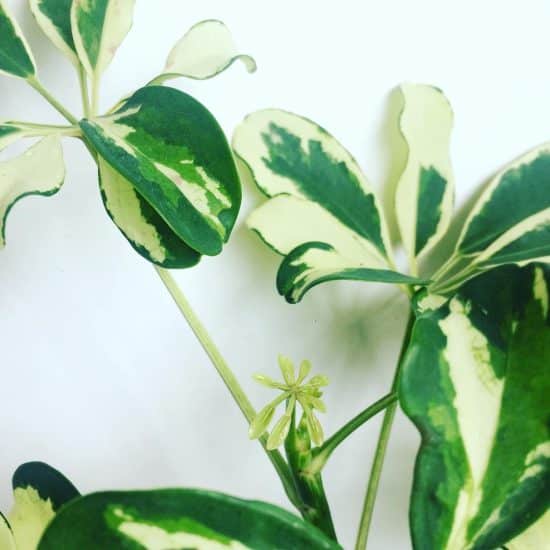
While your Dwarf Umbrella Tree is one of the tougher indoor plants, it may occasionally run into common issues. Here are some of the problems to look out for, as well as practical solutions to keep your plant happy.
Drooping Leaves
If you have drooping leaves on your hands, chances are it’s because your Schefflera plant isn’t getting enough water, humidity, or bright enough light. First, check the soil’s moisture — if the top few inches feel dry, it’s time to water deeply.
For an extra humidity boost, place a tray filled with water and pebbles under your Schefflera plants, or try using a humidifier nearby.
If you suspect your plant isn’t getting enough light, move it to a brighter spot or try using an LED grow light.
Yellow Leaves
Yellow leaves can point to a few different problems, like overwatering, too little light, or even lack of nutrients. If the yellow leaves on your Schefflera houseplant are also mushy to the touch, overwatering is the culprit. To fix this, let the soil dry out between waterings and make sure you’ve got proper drainage going on.
If you’ve got yellow leaves along with leggy growth or dropped foliage, your plant might be craving more sunlight. Scoot it over to a brighter spot but be careful not to expose it directly to the intense mid-day sun.
Lighter green leaves with a yellowish hue could signal a nutrient deficiency. In this case, up your fertilizing routine, especially during the active growing season.
Burnt Leaves
Burnt-looking leaves with brown or black spots mean your Dwarf Umbrella Tree might be getting a bit too much sun. While it loves bright light, direct sun during the heat of the day can scorch its leaves. It will do better in a spot with bright indirect light throughout the day, or by using a sheer curtain to block the harshest rays of the sun.
Keep an eye on your plant for a few weeks and trim away any badly burnt leaves to make way for fresh, new growth.
Pests and Diseases
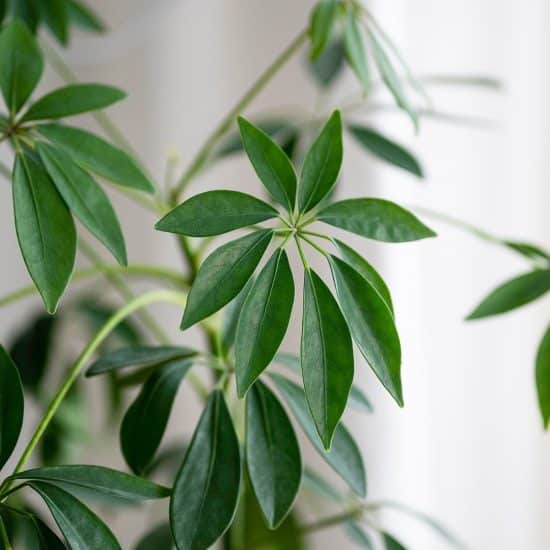
Your Dwarf Umbrella Tree may also face the same challenges as many other indoor plants, including common pests like spider mites and mealybugs, and other problems like root rot.
Root Rot
Overwatering Schefflera plants or leaving them sitting in standing water will often lead to rotting roots. If the leaves start to show dark spots, this is a good indicator that you might have a problem. To confirm, gently check for discolored, mushy, or slimy roots.
To fix this problem, carefully remove the plant from its pot and trim away any rotten roots with sterilized scissors or pruning shears. Then, replant your Dwarf Umbrella Tree using fresh, well-draining mix, and make sure you’re using a pot with proper drainage holes. If you reuse the same pot, it should also be sterilized. (For a natural solution, try one part vinegar to one part water).
In the future, avoid rotting roots by letting the soil dry out a bit more between waterings. And don’t forget to empty the saucer under the pot to avoid standing water!
Mealybugs
These tiny white insects love most houseplants, and your Schefflera arboricola is no exception. They look like cottony masses on the leaves and stems and can stunt the plant’s growth if you don’t take action.
First, gently wipe away visible mealybugs with a damp cloth or cotton swab dipped in rubbing alcohol. If the infestation is more severe, grab some insecticidal soap or neem oil and follow the directions on the label. Make sure you get all the affected areas, even the sneaky undersides of the leaves.
To help prevent mealybugs from coming back, regularly wipe the leaves of your Schefflera plant with horticultural or neem oil. Help your plant fight new infestations by keeping it healthy through proper watering and fertilizing during the growing season.
You can also let it enjoy the great outdoors during warmer months — natural predators will help keep these bugs in check.
Conclusion
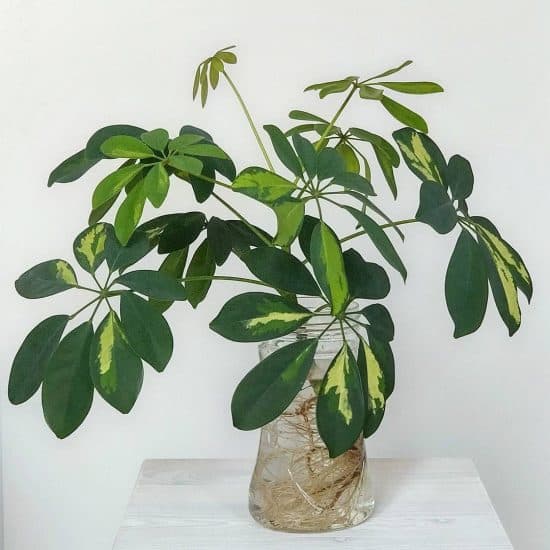
That’s a wrap on our Dwarf Umbrella Tree care guide!
Dwarf Umbrella Tree care summary:
- Provide your Schefflera plant with bright indirect light, avoiding scorching direct sunlight.
- Water thoroughly and consistently when the top few inches of soil feel dry.
- Avoid cold drafts and drastic temperature fluctuations and take measures to increase humidity if you notice wilting or browning leaf edges.
- Use a general potting mix with added perlite, pumice, or LECA to ensure good drainage.
- Repot annually to encourage growth.
We hope this in-depth guide has been helpful in setting you up for success on your umbrella plant journey.
Don’t hesitate to share this guide with friends and other Schefflera arboricola enthusiasts. If you have any questions or need further guidance about any aspect of Schefflera care, don’t hesitate to reach out to us.
Happy gardening, and take care!
FAQ
Does the Dwarf Umbrella Tree clean the air?
You betcha! Schefflera arboricola, also known as the Dwarf Umbrella Tree, is one of those fantastic plants that help purify your air. This indoor plant acts like a natural air filter, absorbing pollutants such as formaldehyde, benzene, and other harmful toxins.
Is Dwarf Umbrella Tree care easy?
Absolutely! This resilient indoor plant is incredibly adaptable, thriving in most indoor environments. It’s not super demanding when it comes to watering — just be sure to let the soil dry out a bit between drinks and make sure its pot and soil mix allow for good drainage.
Keep your plant in bright, indirect light and give it a slow-release fertilizer during the growing season for ideal results.
Is Dwarf Umbrella Tree toxic?
Yes. According to the ASPCA, all parts of the Dwarf Umbrella Tree contain compounds that pets and small children shouldn’t ingest, including calcium oxalate crystals.
